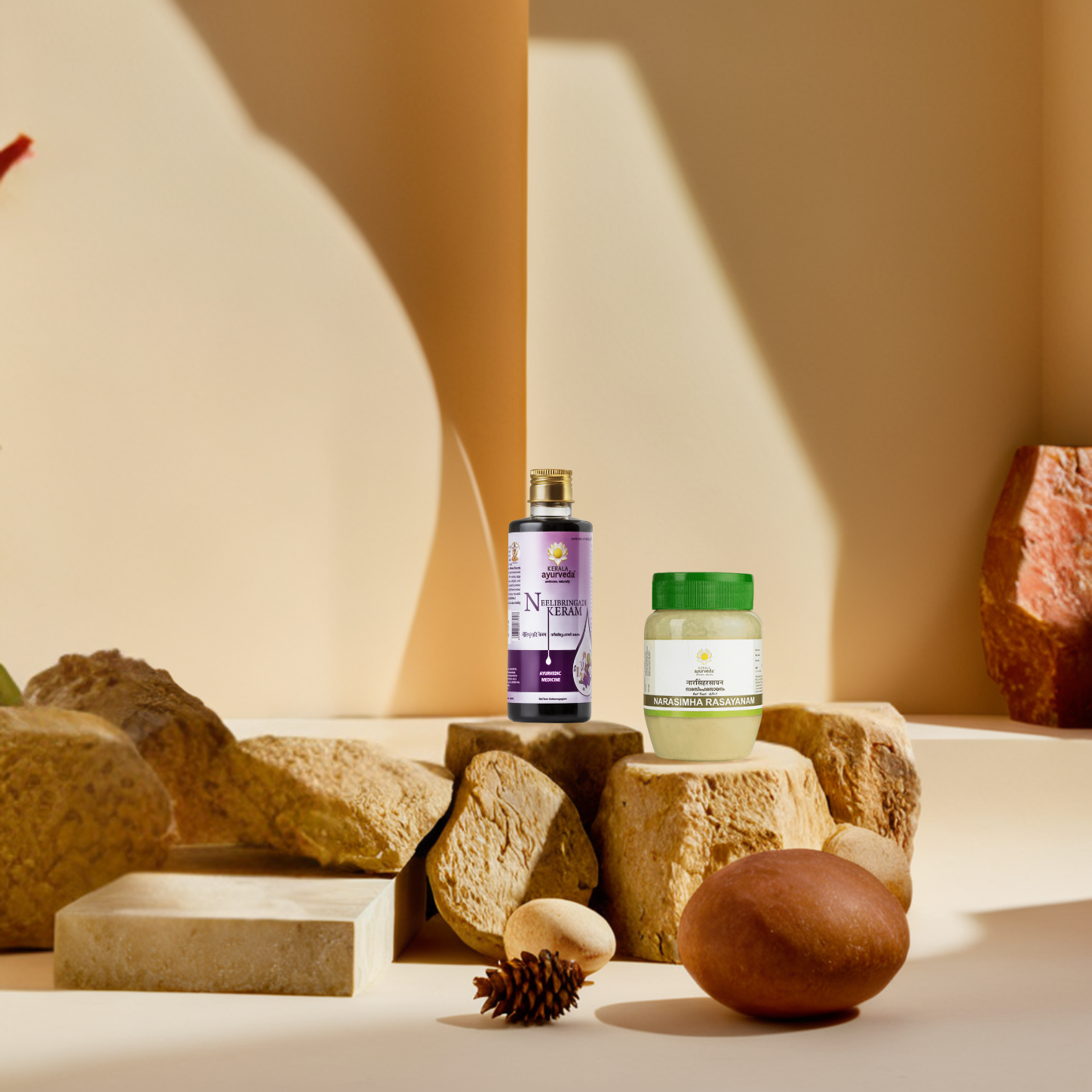Highlights
Have you ever noticed how some people seem naturally grounded, calm, and less inclined towards vigorous activity? Ayurveda, the ancient wisdom of life, offers a beautiful framework for understanding these individual differences. It posits that we are all composed of five fundamental elements: earth, fire, water, air, and space. The unique way these elements combine within us gives rise to what we call a Dosha, or bodily constitution. The three primary Doshas are Vata, Pitta, and Kapha.
Each individual carries all three doshas in varying proportions, but typically one or two predominate. Recognizing your dominant dosha allows you to align your lifestyle, diet, and mindset for optimal health. In this article, we explore Kapha dosha: its traits, signs of imbalance, and ways to harmonise it naturally.
What is Kapha Dosha in Ayurveda: Kapha Meaning
The Kapha Dosha primarily arises from the union of water and earth elements. It embodies the characteristics of both: the stability, steadiness, and firmness we associate with earth, alongside the fluidity, lubrication, and coolness of water. Think of Kapha as the force that provides structure and holds everything together within us.
Kapha Body Type
Individuals with a dominant Kapha constitution often have a larger body frame. They tend to appear solid and well-built, with rounded joints and a strong, substantial bone structure. A characteristic of the Kapha body is a tendency to gain weight relatively easily. The primary locations of Kapha in the body are the chest area, lungs, and throat. People with this Dosha typically have skin that is lustrous and oily, often fair and cool to the touch, reflecting the influence of the water element. Their hair is usually strong, thick, and may be wavy or curly. They often have deep-set, dark eyes.
Emotional and Psychological Tendencies
Kapha types don’t just bring steadiness to the body. Their emotional world reflects that same calm strength. Here’s what the inner world of a Kapha often looks and feels like:
- Compassionate and calm in their demeanor.
- Grounded and rooted, providing a sense of stability.
- Composed and not easily provoked, embodying inner coolness.
- Capable of hard work but may lean towards ease, and can be prone to inactivity.
- Content and valuing stability, they may resist change without a strong reason.
- Easygoing and empathetic, fostering strong social connections.
- Rarely selfish, often prioritizing the needs of others.
- Loving and giving at their core, with a calm and steady mind.
What does Kapha in Ayurveda Look Like?
When Kapha falls out of balance, it can feel a bit like too much stillness, like things are stuck or slowed down, both in the body and the mind. These shifts are your body’s way of asking for a little reset. Here’s what that might look like when Kapha’s off track:
- Physically: It often resembles a common cold with excessive mucus production, leading to nasal congestion and chest discomfort, potentially manifesting as seasonal sensitivities. Digestive issues can arise, causing a sluggish stomach and a feeling of heaviness.
- Contributing Factors: Diet plays a significant role, with oily and sticky foods lacking warmth or nourishment being common triggers. Insufficient physical activity can worsen these imbalances. Emotionally, overeating and seeking comfort in food during stress can lead to weight gain and a general feeling of heaviness.
- Emotionally and Mentally: An imbalanced Kapha can lead to feelings of sadness and dissatisfaction, often linked to a sedentary lifestyle. Lethargy, a lack of motivation, and difficulty concentrating are also telltale signs of emotional turbulence due to aggravated Kapha.
Effective Ways to Balance Kapha Dosha
Fortunately, Ayurveda offers numerous ways to address a Kapha imbalance, promoting not only a healthy life but also a fulfilling one that respects your body's elemental composition and caters to your unique needs. A comprehensive approach involving the right diet and lifestyle adjustments can bring about balance.
Kapha Dosha Diet
The key to maintaining a balanced Kapha lies in counteracting its inherent nature through foods with opposing qualities. Kapha is characterized by heaviness, coolness, smoothness, and oiliness. Therefore, a helpful dietary approach involves incorporating foods that are light, warm, dry, and perhaps a bit rough. Consider adding these enriching foods to a Kapha-balancing diet:
- Light Foods: Choose less dense fruits like apricots, berries, apples, watermelon, and pears. Avoid heavier, textured fruits such as oranges, bananas, pineapple, and coconuts. Opt for light beverages such as black and green tea.
- Warm Foods: Utilize warming spices in your cooking. Drink warm water throughout the day and enjoy warm teas, especially with cardamom and cinnamon. Honey, being naturally warming, is a good addition in moderation. It's advisable to avoid cold water, chilled drinks, and frozen foods.
- Dry Foods: Cook with minimal oil or ghee. Incorporate dried foods such as beans and dry fruits. Grains are a valuable addition to the diet, whether as seeds or ground into bread. Remember to limit oily and fatty foods like cheese, excessive dairy products, buttermilk, and coconuts. Minimize your intake of wheat. Consume fruits and vegetables with a high water content in moderation.
- Rough Foods: Prioritize fiber-rich foods to help manage excess mucus and aid detoxification. Good sources include cereals like oatmeal and bran flakes for breakfast.
Dried fruits such as plums, dates, apricots, and raisins can be included between meals, along with moderate amounts of certain fruits like oranges and strawberries.
For main meals, vegetables like spinach, broccoli, and carrots are ideal, and legumes, including lentils and kidney beans, are great sources of roughage. Consider occasionally replacing white rice with brown rice, along with incorporating barley and wheat bran.
Kapha Dosha: Foods to Avoid
To prevent the aggravation of Kapha, it's helpful to be mindful of certain food categories and their impact on this dosha.
- Sweet Foods: Limit both refined sugar, processed items, and naturally sweet foods like root vegetables and nuts, as their heavy, oily, and moist nature can provoke Kapha, potentially leading to sluggishness and reduced motivation.
- High-Moisture Foods: Consume foods with very high water content cautiously.
- Very Sour Foods: Reduce the intake of very sour fruits and other sour foods.
- Excessively Oily Foods: Avoid foods cooked in excessive amounts of oil.
- High Protein Foods: Consume high-protein foods in moderation.
Easy Recipes to Support a Kapha-Friendly Diet
Here are a few straightforward recipes incorporating spices and ingredients that can help balance Kapha Dosha and promote overall well-being. These recipes utilize warming spices and are generally easy to prepare for various meals.
1. Roasted Rice
- Ingredients: 1 cup of Rice, 1 tbsp Ghee, ¼ tbsp Cardamom, Dates, ¼ tbsp Cinnamon, 3 cups of Water, 2 pinches of Salt.
- Preparation: Heat ghee in a saucepan, add rice, and cook until coated. Stir in cardamom, cinnamon, and chopped dates. Add water, cover, bring to a boil, then simmer until rice is soft. Serve hot.
2. Moong Dal Khichdi
- Ingredients: 1 cup Rice, 2 tbsp Ghee, ½ cup moong daal (soaked), ¼ tbsp Cardamom, ¼ tbsp Cloves, 1 tsp Cumin, 4 Bay Leaves, ¼ tbsp Cinnamon, 1 inch Ginger (paste), 4 cups of Water, ¼ tsp Salt.
- Preparation: Boil soaked moong dal in water, drain, and add 4 cups of fresh water. Sauté a paste of cinnamon, cardamom, cumin, and ginger in ghee until brown. Add this to the dal broth with bay leaves, salt, cloves, and rice. Cover and cook until rice is tender. Serve warm.
3. Apple Smoothie
- Ingredients: 1 Apple (chopped), 1 pinch of Cardamom, ⅛ inch Ginger (grated), ½ cup of Water, ½ Lime (juice)
- Preparation: Blend chopped apple, grated ginger, ground cardamom, and lime juice with water until smooth. Serve immediately.
Lifestyle Adjustments for Kapha Balance
Certain lifestyle modifications can enhance the effectiveness of a Kapha-balancing diet. Incorporating these daily practices can help maintain equilibrium.
- Seeking Warmth: An overactive Kapha can lead to excessive coolness. Prioritize staying warm by wearing appropriate clothing and making your environment warm and dry. Consuming warming foods like dry fruits, warm water, warm tea, and nuts is essential.
- Switching Up Routine: Lethargy and a feeling of stagnation are common with Kapha imbalance. Introducing novelty and excitement by changing your routine, meeting new people, or engaging in new recreational activities can be very beneficial for psychological well-being.
- Monitoring Sleep: An irregular sleep schedule can exacerbate low energy levels. Aim for a consistent sleep pattern, ideally falling asleep between 11 p.m. and midnight and waking up between 6 a.m. and 7 a.m., to combat lethargy associated with Kapha imbalance.
- Occasional Fasting: Since Kapha imbalance can create a feeling of heaviness, occasional fasting can help eliminate this and restore a healthy appetite.
- Regular Exercise: Physical activity is crucial for combating lethargy and promoting an active mind and a healthy, energized body.
- Yoga for Kapha Balance: Specific yoga poses can be particularly beneficial for clearing Kapha imbalance. Kapha Yoga often includes poses that are accessible and comfortable for this body type, such as Natrajasana, Utarasana, Twisting Chair pose, Tree pose, Warrior pose, Triangle pose, Headstand, Half Moon pose, Bow pose, and planks. Kundalini Yoga and Kapalabhaati Pranayama are also considered effective for maintaining respiratory health and circulation, aiding in managing excessive mucus.
Conclusion
Understanding your Kapha constitution provides a meaningful lens through which you can recognize your natural strengths, such as stability, compassion, and calm, as well as your tendencies toward imbalances like lethargy or heaviness. With the help of Ayurvedic insights on diet, lifestyle, and daily routine, you can bring your Kapha into balance, nurturing greater vitality and emotional clarity.
Kerala Ayurveda supports your wellness journey with time-honored formulations and expert guidance rooted in classical Ayurvedic knowledge. Discover our range of offerings to naturally awaken your system, encourage lightness and flow, and reinforce the grounded resilience that defines the Kapha dosha.
FAQS
1. What is Kapha Dosha, and what elements is it composed of?
Kapha dosha is one of the three fundamental energies in Ayurveda, composed of the water and earth elements. It is responsible for structure, stability, lubrication, growth, and immunity in the body.
2. What are the main qualities (gunas) of Kapha dosha?
Kapha is characterized by heaviness, coldness, slowness, steadiness, softness, and oiliness. These qualities provide physical and emotional grounding, nourishment, and resilience.
3. How can you recognize a Kapha imbalance?
Signs of Kapha imbalance include sluggishness, excess sleep, weight gain, water retention, impaired digestion, respiratory congestion, and emotional patterns like attachment or lethargy.
4. Which tastes and foods increase or decrease Kapha?
Sweet, sour, and salty tastes increase Kapha, while pungent, bitter, and astringent tastes help pacify or decrease Kapha. A Kapha-balancing diet emphasizes light, warm, and dry foods.





